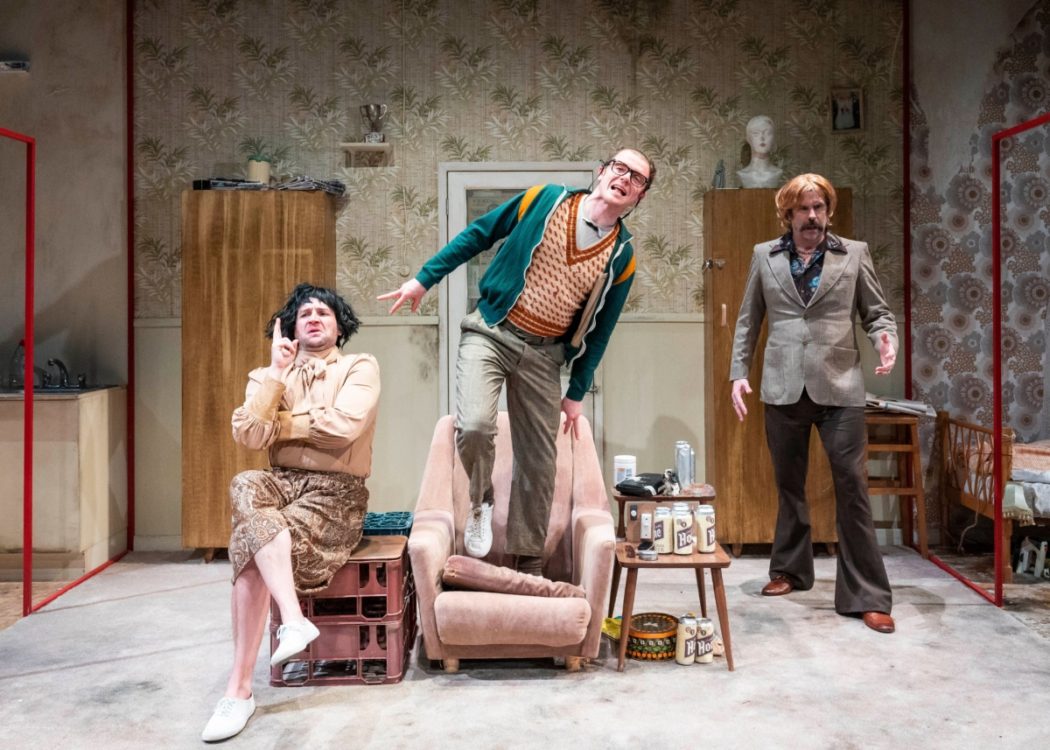The lights go up on a stage where three men are in three rooms side by side. This is a grotty, inner city flat with a 1960s kitchen, cans of lager on the floor and a picture of the Pope over the sink.
The man in the kitchen is putting shopping away and looking in a bemused way at a sausage; in the middle a man in a wig is polishing a trophy; in the bedroom a man in his underpants is putting on a skirt and bouse.
Sometimes falteringly, they start to interact, to perform a play, a bizarre and grotesque act of family life. Here playwright Edna Walsh’s exalted language with its extravagant metaphors and flights of fancy take the production to heights of the ridiculous and tragic.
We begin to pick up on their stage conventions: Mammy and Daddy are represented by small cardboard coffins; going into the cupboard represents going outside; the four women of the family appear as wigs of different colours worn by all three men though Blake is the female lead.
Their drama is of an Irish childhood, but also of danger, violent death, greed and escape. These are mixed with memories of home: the smell of mother’s cooking and of woollies worn too long and of pink wafers broken up into heart shapes.
These fragments of remembered family life are given an almost supernatural meaning. Dinny received the boys from Ireland and coerced them into repeated performance of the family dynamic. He holds out before his sons the prize, a trophy cup, to be given to the best actor that day, because every day they perform the same mummery of family life in a 14th floor flat.
On one level this is a romantic tale of the Irish diaspora, how people brought up in the green fields of the west of Ireland long for the past after they have emigrated to the gritty streets of South London. On another it is a drama like a Greek tragedy with each character fixed in a pattern of behaviour set in events years ago, who must play out again and again the family psychodrama.
Every single performance here is first class. The prime mover Is Dinny, played by Dan Skinner, who thinks he is flash with his suit and rings, but really appears as a man trying to over-compensate by threat for his own deficiencies. Sean, the youngest son, played by Emmet Byrne, wants to leave this life but is entrapped by their bullying and his own meekness. His elder brother Blake, played by Killian Koyle, desperately wants his father’s love and does anything to perfect his acting to be declared the best so he can win the acting trophy today.
The tragic farce is directed at breakneck speed by Nicky Allpress who has done a skilled job of linking frantic exits and entrances, costume and character changes with the playwright’s seemingly random changes of mood and direction.
Enda Walsh is a playwright from Cork who lived in Walworth when he first came to London and whose work invites comparison with his near contemporary Martin McDonagh. McDonagh was born just down the road from the Southwark Playhouse’s Elephant and Castle location, in Camberwell, but takes much of his inspiration from his family home in Galway.
In the second half of The Walworth Farce another character is introduced, Hayley, a friendly Tesco counter girl played with charm and vulnerability by Rachelle Diedericks, only slowly becoming aware of how sinister is the game being played in the place where she has only come to do a good deed.
Without giving the plot away, two knives appear late in the production and the resolution , such as it is, does not address the questions posed by the play. To be fair, however, there is no resolution of many intractable family dilemmas.
Even with the family tree drawn out in the programme, I never did understand the relationships between all the people who populate the fantasy world of Dinny and his sons but that might be a reason for seeing it again, which would be worth the trouble.
It is excellent to see a play of this vitality as the first major production in London’s newest theatre. The Southwark Playhouse Elephant is itself a testament to the popularity of playgoing in today’s culture. It is a superb theatrical space, fitted out with two bars, I look forward to many great productions in the future.

